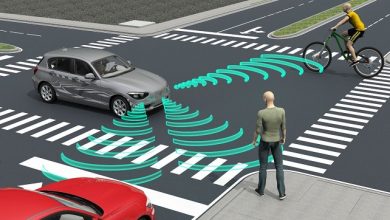Mobility First: Autonomous Meets Mobility as a Service
By Mark Thomas, VP, Marketing, RideCell
There’s been much noise in the past few years about mobility-as-a-service. We’ve seen the birth of multiple service models that are making urban mobility seamless, smarter, and altogether a better experience. With the explosive growth of companies like Uber and Lyft, people in US and European metro areas now have access to on-demand rides, gaining many of the benefits of vehicle ownership without ever having to drive a car.

There’s also been huge noise about the upcoming autonomous revolution—because the next big mobility transformation is with self-driving vehicles. When autonomous intersects with mobility-as-a-service, transportation will change forever.
The Inflection Point.
In the autonomous future, there will be no drivers. Uber’s value-add of recruiting and retaining massive numbers of drivers goes away as a critical success factor. The likes of Uber and Didi will be challenged by new mobility companies with expertise in managing a fleet and maintaining the condition of every vehicle.
With driverless cars, the economics of offering a ridesharing service will shift. Today’s driver-based service offerings are still considerably more expensive than car ownership. But when you take the driver out of the equation, the cost of offering a ride drops dramatically. It becomes feasible to get to a price of 35 cents a mile, at which point it’s significantly less costly to use a ridesharing service than to own the vehicle.You won’t need auto insurance, you won’t need hunt for parking, and you won’t even need a license anymore—so those DMV nightmares will be a thing of the past.
This is the inflection point when using a ridesharing service is less expensive than using your own car and mobility-as-a-service emerges as the preference over vehicle ownership.
After the Revolution.
What if nobody owned cars anymore? The automotive business will no longer exist in the same way, with the same companies, as we know it today. And that future is not far out.
If we look back at the music industry—just 15 years ago—we remember that the record labels had all the power. The record stores and then later CD stores were like the dealerships in the automotive industry. As we know, famous music retailers such as Tower Records are long gone. Most people today consume music digitally, increasingly through subscription services.So it’s now Spotify, Apple, Amazon, and other music service providers that are making the money instead of the labels.
A similar story will play out in the automotive industry. The profits will likely migrate to the service providers, away from the car companies and dealerships who focus on selling cars.In fact, in this new era, car manufacturers may end up selling their cars directly to the new mobility service providers. They’ll lose their margins—and, worse, they’ll lose their brands.
But the autonomous revolution doesn’t signal the demise of the auto business. Car companies that invest heavily in mobility services are the ones that will survive and will reap the benefits.
ReachNow — A Case in Point.
Today’s car companies have the opportunity to change, to transform their business models, and to align with a new way to do transportation. Take a look at ReachNow, a BMW business that offers carsharing and chauffeured rides. Currently, offered in the progressive Portland and Seattle markets, ReachNow uses a premium fleet of BMW and Mini vehicles.
The ReachNow reservation experience is through an app, but the service is far more than an app. It’s also about authenticating and onboarding drivers within minutes. It’s about dispatching drivers, matching users with cars and rides, and balancing the vehicle supply and demand. Plus, there’s setting dynamic pricing, handling payments payment, and analyzing the service usage data.
ReachNow is unique because a single app delivers both rideshare and car share options—so it appeals to a wider range of customers. Imagine a scenario where the consumer hails a ride share, but the wait time is longer than acceptable. ReachNow knows a vehicle in their car share program is parked just around the corner and offers a carshare option to the consumer. The rider/driver gets on the road faster, and ReachNow gets a satisfied customer.
This multiservice model also results in operational efficiencies, because ReachNow can use the same fleet of cars to offer chauffeured rides and to offer cars for rent by the minute. And they can juggle the fleet.If demand for ridesharing spikes, ReachNow can pull vehicles from their car share fleet and put out an alert for drivers—or vice versa. Since car sharing has a different peak demand curve than ride sharing, this flexibility enables ReachNow to serve two different markets with a single fleet.
The Time to Act Is Now.
Automotive OEMs need to learn this new mobility market. It involves expertise and processes that most car companies have never had to think about before—managing a fleet of vehicles, ensuring they all have gasoline or a full charge, washing the cars inside and out, and handling persistent communications with consumers who’ve never had a close relationship with any car company in the past.
As we move rapidly towards the new mobility future, these skills will make or break success.How to get started? Try launching one standalone service—whether it’s carsharing, ridesharing, carpooling, or even five cars parked in a residential housing complex. No project is too small.
When you do that, make sure that you enter with the most flexible technology, one that can adapt as your vision evolves. As soon as you’re doing carsharing, you may want to offer a premium service with chauffeurs. So choose a platform that allows you to add services, to grow your business, to attach customers to a single app—without having to find a new vendor or reinvent the technology.
The ReachNow new mobility service runs on the RideCell platform. RideCell makes a white-label solution that makes it easy for car companies to brand and launch a new mobility service in a matter of months. RideCell handles all the technical aspects of managing a ridesharing or carsharing operation (or both). End-to-end automation covers onboarding new riders, checking IDs, dynamic pricing, driver-rider matching, ride scheduling, payment processing, demand-supply balancing, personalized settings, fleet conditioning, and even referral programs and promotions.
As you get started in the service business, you’ll be learning what works and what doesn’t. In addition to real-time analytics, where things are right now, RideCell provides post-processing analytics. Where are you seeing a lot of traffic? What if you had added two more drivers? What if you add more cars? At what point are there diminishing returns? Which of your vehicle models work best for shared rides? You’ll get the kind of data that will help you turn the highest-possible profit.
What will the world be like when transportation becomes a service? Service providers will own and operate their own fleets of vehicles. If you look to airline travel as a similar end state, where flying is the service rather than driving, it’s clear that the market can support multiple brands and companies that offer services—but very few companies actually building planes or cars.
The time is now for auto OEMs to embrace the reality of new mobility services and offer one (or several) of their own. RideCell is here to help them make this transition as quickly and profitably as possible.


